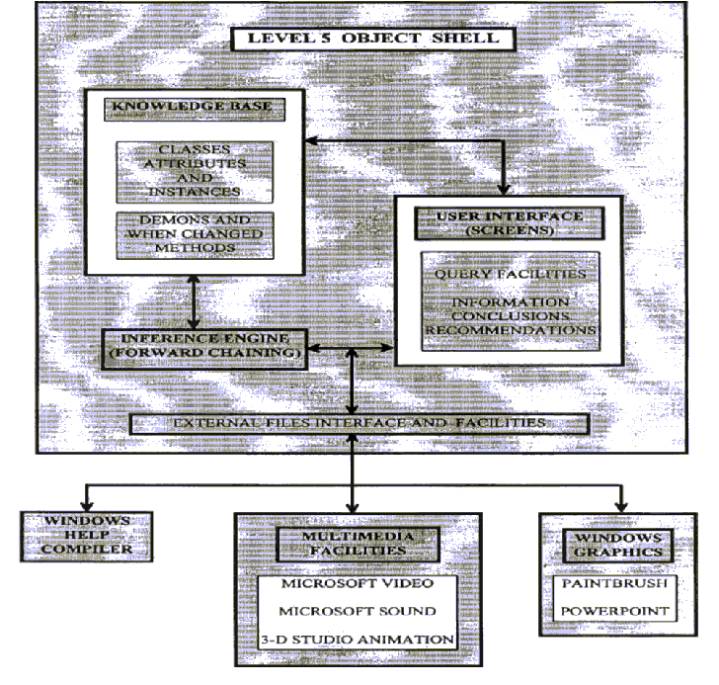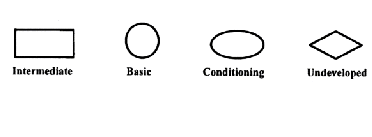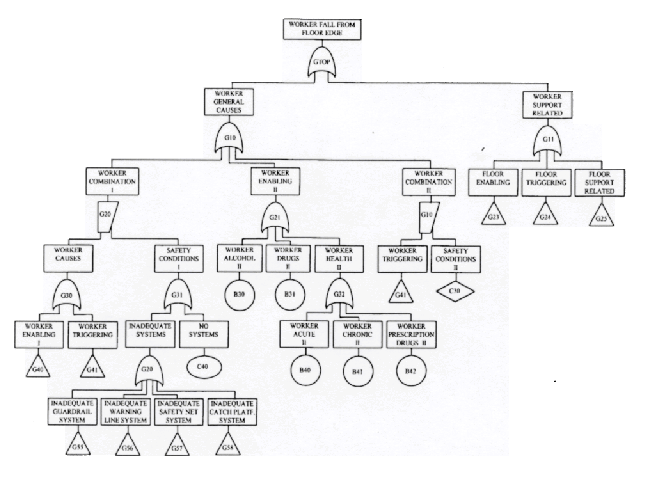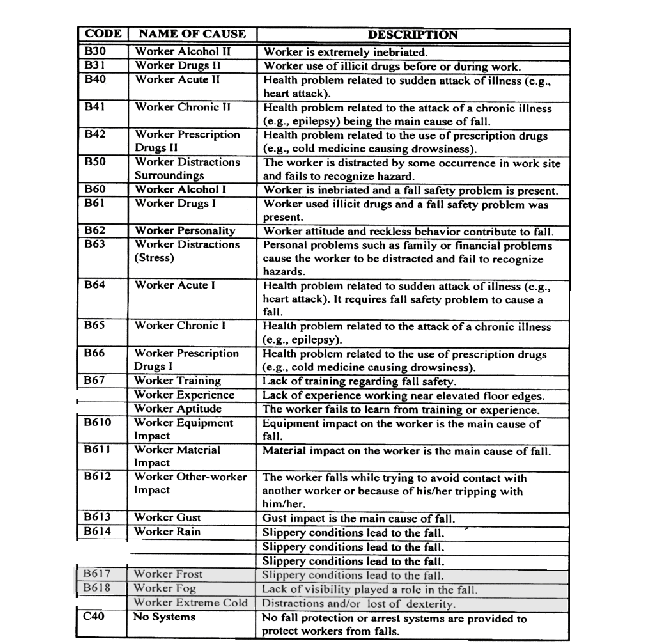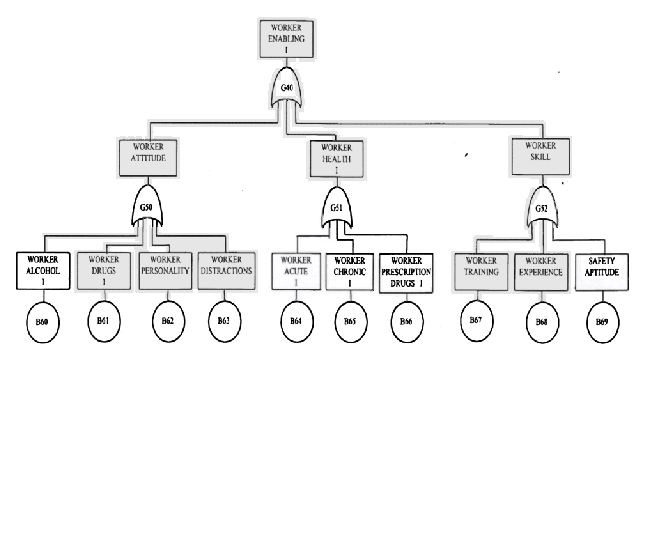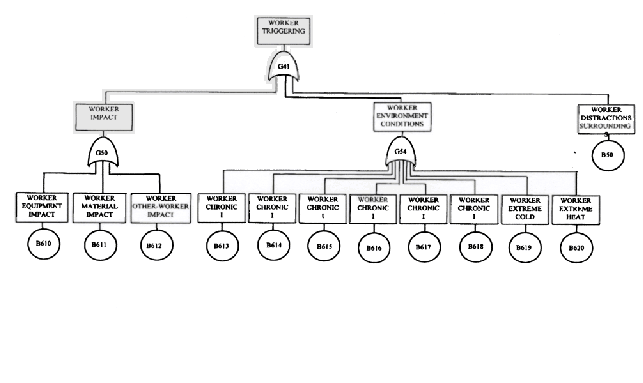|
(pressing HOME will start a new search)
|
|
Knowledge Acquisition and Knowledge Structure for the Safety First Expert System
Carlos
A. Vargas and Fabian C. Hadipriono
Department
of Civil Engineering
Ohio
State University
Columbus,
Ohio
|
Construction fall accidents have been identified as a leading cause of construction injuries and deaths. Unfortunately, most literature does not adequately address the causes of falls. The knowledge of experts in the construction safety field has been underutilized and should be used to identify the causes of construction falls. To take advantage of this knowledge, the SAFETY FIRST expert system is being developed. The objective of the system is to assist in the determination of the causes of fall accidents and recommend ways to prevent their future occurrence. Throughout the development process of SAFETY FIRST, the importance of the knowledge acquisition and knowledge representation tasks was highlighted. This study reveals the feasibility and importance of using experts' knowledge to determine the causes of construction fall accidents and the advantages of using fault tree structures to represent this knowledge. Keywords: Knowledge Acquisition, Knowledge Structure, Safety, Construction Falls, Floor Edge, Expert System. |
Introduction
In
the United States, construction fall accidents have been identified as a
leading cause of construction injuries and deaths. Furthermore, OSHA has found
that falls make up about 33 % of all construction-related fatalities [Korman
et al. 19901. This trend has prevailed despite attempts by government
regulatory agencies and industry-related groups to reverse it.
The
first step in solving this problem is the identification of the causes of
these fall accidents. Once this is done, both construction companies and
government agencies will be able to focus their attention on the "weak
links" (problem areas) of construction sites and take the corresponding
safety measures to prevent their occurrence. As a consequence, the number of
disabling and fatal injuries in construction sites may be reduced
substantially.
Unfortunately,
the causes of construction falls are seldom discussed in detail in the
existing literature. In addition, experts' knowledge and experience are too
rarely used in investigating the causes of construction falls. Both of these
factors prompted the development of SAFETY FIRST, an expert system whose
objective is to assist in the determination of the causes of fall accidents.
This work is based on an earlier study used to develop FTES FALL, a fault tree
expert system prototype developed for falls investigation [Hadipriono 1992].
The earlier and most important stages in developing this system are the
identification of the causes of fall accidents in the construction industry
(i.e., knowledge acquisition) and the representation of this knowledge in the
form of fault tree structures (i.e., knowledge representation). Although
these~stages are the focus of this paper, a discussion of the architecture of
SAFETY FIRST is essential to illustrate their importance to the development
process.
The
Architecture of Safety First
The
SAFETY FIRST expert system has two main functions: to determine the cause(s)
of a fall accident that has already occurred and to identify potential problem
areas (weak links) regarding fall safety in a construction site. To perform
these tasks, the system consists of five main components: the knowledge base,
the inference engine, the user interface, the external files interface, and
the external files (Figure 1). The first four components are all contained
within the Level 5 Object expert shell selected to develop the system. This
shell was selected because it provides all the necessary facilities to assist
the developer in the construction of the knowledge base, and, fiuther more, it
allows for the development of a user-friendly program.
|
|
|
Figure
1.
The Architecture of SAFETY FIRST |
The
knowledge base contains all the knowledge obtain from the experts regarding
the causes of construction fall and the process they follow to identify these
causes (mainly heuristic knowledge). This knowledge is represented b using
fault tree structures which can be represented in the system's knowledge base
by a combination of production rules and objects.
All
of the events and causes in the fault tree knowledge structure are represented
as either classes, attributes, or instances in the knowledge base, while the
logical or empirical relationships among these events or causes are
represented in the knowledge base by using production rules.
In
order to reach a conclusion (causes of a fall accident or weak links in a
construction site), the system needs to know the conditions in the
construction site at the time the fall occurred or the current safety
conditions in the site being evaluated. This is the main task of the user
interface r mechanism: prompting the user for the information required to
solve a problem. Other tasks of this component are to provide help to the
user, to explain why a given conclusion has been reached, and to provide
recommendations on how to avoid future fall occurrences. To do this, the user
interface has to be able to interact with all the other modules of the system.
It interacts with the inference engine and the knowledge base to determine
what information should be required from the user. Finally, it interacts with
external files to provide a more user-friendly system, including help
statements and multimedia capabilities.
Finally,
Level 5 Object also allows the system to read the external files needed during
a consultation. The inference engine determines which of these files should be
called depending on the information provided or requested by the system's
user. The SAFETY FIRST system will use the windows help compiler to provide
users with clear and friendly explanation facilities. In addition, the system
will retrieve text files containing conclusions and recommendations, and
bitmap files containing graphic samples of conditions in a construction site.
Finally, in order to make the system even more user-friendly, we take
advantage of multimedia facilities like video (using Microsoft Video), sound
(using Microsoft Sound), and animation (using 3D Studio). Fall accidents are
rarely captured on video, and pictures cannot give a user an accurate idea of
the mechanisms involved in a fall. This is the reason for the use of the
animation package. It provides the user with a simple simulation of the ways
in which a fall from a given structural component may occur.
In
order to construct the knowledge base of SAFETY FIRST as described above, the
knowledge to be used had to be acquired. This was mainly done during the
knowledge acquisition and representation tasks which are the focus of the rest
of this paper.
Knowledge Acquisition for “Safety First”
Generally,
knowledge acquisition is defined as "the process of eliciting and
enumerating the knowledge of an expert in a particular field (domain) so that
this expertise can be coded into an expert system" [Bride and Blount
1989]. During this stage most of the knowledge required to create a decision
support system is acquired, analyzed, and organized. This section includes a
general description of the knowledge acquisition process for the SAFETY FIRST
project.
In
general, three parties play an important role in the success of the knowledge
acquisition process: the knowledge elicitors, the knowledge programmers, and
the experts. The knowledge elicitors are in charge of interviewing the experts
and trying to elicit knowledge from them. They also plan the topics to be
covered during the interviews and lead the flow of the conversation so as to
maximize the amount of useful information obtained. The knowledge programmers,
sometimes called software engineers, are in charge of taking the knowledge
elicited from the experts and converting it into structures and codes that can
be used in the computer. Both the knowledge elicitors and the software
engineers are also known as knowledge engineers. Finally, the experts are the
people whose knowledge or experience in a given domain is going to be
represented by an expert system. The experts also verify the applicability and
correctness of the expert system and indicate whether or not changes are
necessary.
The
knowledge acquisition process is generally subdivided into four phases: the
preliminary, intermediate, advanced, and organization phases. The preliminary
phase of the knowledge acquisition process involved several activities,
including reading articles and any other literature available on the subject,
selecting the professionals who qualify as experts in the field, and finally,
meeting the chosen experts and asking them to participate in our project. The
authors performed the function of knowledge elicitors and knowledge
programmers.
For
the preliminary selection of the experts, three points were considered. First,
the expert had to be recognized by people in the industry as knowledgeable in
the general area of safety and, specifically, in the construction falls area.
Second, the expert had to live within our proximity so that he/she would be
easy to reach at all times. A final consideration was the amount of time the
expert was willing to give to this project. All of the experts chosen were
willing to dedicate a reasonable amount of time, given the constraints of
their jobs.
After
the experts were selected, the first interview with each of them was
conducted. The main objective was to make the experts and the knowledge
elicitors feel at ease with each other. During this interview, there was a
preliminary discussion about the project, the characteristics of the research
process, and the goals of the project. At that time, the objectives of the
project and the process required to develop an expert system were explained to
the experts. Finally, the knowledge elicitors and the experts decided on the
best place and time to meet for future interviews and any other rules to be
considered (e.g., whether or not the expert(s) would allow the knowledge
elicitor to record their conversations).
At
the beginning of the first interviews, the experts seemed to be hesitant about
the project and its objectives. For example, when the knowledge elicitors
asked one of the experts if their conversation could be taped, the expert's
reservations about the project were evident. The immediate response was
"no." The expert cited legal problems to explain his answer. In the
interview, Any questions the experts had about the project or expert systems
over all were answered. Finally, during this discussion the participants got a
chance to know each other and to lay a good foundation for future interviews.
Next,
in the intermediate phase, the objective was to focus the experts' attention
on the subject matter. To do this, we created a questionnaire which served as
the second interview with each of the experts. The focus of this questionnaire
was on construction falls from high elevations and it was developed to try to
get each expert to think about construction falls, first generally, and then
in more specific terms. After these interviews, the knowledge acquired was
reviewed and the topics of the next interviews were determined. These topics
included areas that had not been fully explored, or which were still not clear
to the knowledge elicitors after review. Finally, by the end of the
intermediate phase, we had developed preliminary fault tree models for all of
the building components considered significant enough to be included in this
project (e.g., a roof, a floor opening, etc.).
Once
the interview process reached the advanced and organization phases, the
interview topics concentrated on specific details regarding construction falls
from the selected components. The experts also checked the preliminary fault
trees and suggested changes to them (as needed). In addition, any
disagreements among the experts were settled by providing them with more
specific explanations of the variables and parameters involved in the subject
at hand. For example, for a sloped roof component, there was disagreement on
whether or not devices like crawling boards, roofing brackets, and the
so-called chicken ladders could prevent falls. Some of the experts seemed to
think so, while others disagreed. In this case, after further discussions, we
agreed that those devices are useful tools that help a worker perform his/her
job on a sloped roof, but they, by themselves, cannot prevent the worker from
falling and/or protect him/her from injuries if a fall occurs.
All
of the interviews were summarized and kept on record in order to be used later
in the knowledge representation phase. These summaries contain the most
significant information acquired and, depending on whether the expert allowed
taping, they were obtained after careful review of the interview tapes or from
the notes taken by the knowledge elicitor during the interviews.
As
mentioned before, the knowledge acquisition and the knowledge representation
tasks occurred simultaneously starting from the intermediate phase. The
knowledge was represented through fault tree structures. In the next two
sections, we discuss the fault tree development process: first, by providing a
brief introduction to fault tree analysis and, second, by explaining the
development process for one of the structural components studied during this
project.
Fault Tree Development for Safety First
There
are two types of analytical processes that can be used to analyze a system:
inductive or deductive. For a system failure analysis, inductive techniques
would attempt to find out what would happen if some fault occurred in the
system and all the possible failures that may result as a consequence. For
example, if we take the fault "the worker is intoxicated in the
construction site," there are several failures (accidents) that may
result as a consequence (e.g., the worker may fall, be electrocuted, or be
caught-in between some equipment). Therefore, through this method we can
evaluate the importance of avoiding the occurrence of certain events (faults)
in the system.
The
deductive method takes a different reasoning approach going from a given
failure mode (consequence) to the specific causes that may lead to it. In this
case, we consider a given type of system failure (e.g., worker fall) and try
to determine what specific faults (e.g., worker has health problems or worker
is hit by something) may cause or contribute to its occurrence. The fact that
we can focus on one failure mode and determine how it can occur is the main
reason why this type of analysis is used in this project. The focus of this
project is in the causes that may lead to a fall accident. The significance of
a given cause regarding other failure modes is not within the scope of our
study.
Fault
tree analysis is a typical deductive analysis method which seeks to identify
all of the failure modes that can cause a system failure (top undesired
event). In the Fault Tree Handbook, Roberts et al. [19811 defined a fault tree
as a graphic model that shows "all the various parallel and sequential
combinations of faults that will result in the occurrence of the pre-defined
undesired event." The objective of a fault tree is to identify all the
possible ways (paths) in which the top undesired event may occur. Through this
method the analyst can also identify potential "weak links" in the
system being studied and, as a consequence, prevent serious problems or
accidents. It is important to note that the fault tree model is limited in
that it only depicts the events or combination of events that in the analyst's
opinion can lead to the top event's occurrence. Therefore, the scope and
limitations of the analysis must be carefully defined and all the assumptions
clearly stated. Otherwise, there is a chance that the analyst may omit
important input causes.
The
events contributing to the occurrence of the top undesired event are
determined through the use of logic gates, which show the events or
combination of events needed for the occurrence of a higher event. Given a
specific gate, the higher event is the output of the gate and the lower events
are the inputs to the gate [Roberts et al. 1981]. The relationship among the
input events is defined by the type of gate used to connect them. There are
several types of events and gates symbols However here we will only discuss
those used for this project. We will employ the symbols used in the Fault Tree
Handbook published by the National Technical Information Service [Roberts et
al. 1981 ].
Three
types of gates are used in this paper's fault trees: OR, INHIBIT, and TRANSFER
gates (Figure 2). The OR gate indicates a situation in which if at least one
of the input events occurs, then the output event happens. Next, the INHIBIT
gate is used if a basic or primary event occurs simultaneously with a
conditioning event, leading to the output event. In this case, the top event
happens if a basic fault occurs in the presence of an conditioning
(restrictive) cause. Finally, the TRANSFER gate allows the user to develop a
fault tree while avoiding excessive use of symbols on one sheet. The tree can
be broken into several branches depicted on different pages. In addition, this
symbol precludes having to re-draw the branches of the tree that are identical
in several places.
The
symbols of all the events in this study are shown in Figure 3. The rectangle
defines an "intermediate event," which is a fault event resulting
from the input causes acting through a logic gate. Next, the circle defines a
"basic event," which is a cause that requires no further
development. It is also referred to as a primary or generic failure [Barlow et
al. 1975]. Further, the ellipse is used to represent a "conditioning
event," which is an event that includes any restrictions or conditions to
the INHIBIT gate. Finally, the diamond represents an event that is not
developed further, or an "undeveloped event." The reason an event is
left undeveloped is either there is a lack of information or, as in our case,
the event is outside the scope of the study.
The
fault tree system was chosen to represent the acquired knowledge because it
simulates the way experts determine the cause(s) of a tall accident that has
already happened. Several fault trees for several structural components were
developed once the knowledge acquisition from the experts and the literature
was completed and the main causes of falls were identified. The final
objective of these fault trees was to show the causes or combinations of
causes that can lead to a construction fall accident from a given surface.
Therefore, the top undesired event of all the developed fault trees is
"worker falls from a [predetermined surface]." Given this event, the
primary and secondary causes contributing to the fall are determined through
the use of logic gates.
For
SAFETY FIRST, the study has been limited to developing the fault trees to
determine the causes off alls from seven elevated surfaces (floor edge, floor
opening, roof, top of wall, wall opening, steel beam, and ladder), from the
same level, and slips. Furthermore, we are only concerned with falls that
occur during vertical operations, such as the construction of buildings or
residential homes. Events like falls during bridge construction and trench
operations and falls from utility poles are excluded. In addition, we have
focused on the causes of falls over which workers had a certain degree of
control or which acted upon workers and caused their falls. Causes of falls
related to structural components supporting the workers have been identified
in other studies. They will be mentioned but not elaborated on since their
analysis would require a comprehensive structural engineering background, a
field of expertise which is not within the domain of our current experts.
The
first step in developing the knowledge representation structures (fault trees)
was the determination of the causes of falls for each of the structural
components studied. This was done during the knowledge acquisition phase of
the project. As this task progressed, the relationships among the causes and
the top event of the fault tree (worker fall) became more evident, and we were
able to represent them by using preliminary fault tree structures. Later, as
the details about the relationships among causes became even more clear, these
preliminary trees were further refined and organized in a more accurate
structure.
|
|
|
Figure
2.
Gates and transfer symbols |
|
|
|
Figure
3. Event Symbols |
In
this paper, the structure and organization of the developed fault trees is
illustrated by using the fault tree for the event in which a worker falls from a
floor edge elevated component. This fault tree will also show all the
assumptions and constraints associated with the tree's development process.
For simplicity in explaining the fault tree, first, the tree's overall structure
will be described and, second, the basic and conditioning causes of falls from a
floor edge will be discussed in general terms. In addition, a code within
parentheses will accompany the explanation of some of the possible events or
causes. This is the same code used in the partial fault tree structure depicted
in Figures 5 to 7. Within the code, the first letter indicates whether an event
is a gate (G), a basic cause (B), or a conditioning cause (C). Next, a single
digit refers to the level of the event on the tree (assuming the top event is at
level zero). Finally, the remaining number in the code designates the event
number within the level, starting from zero and moving from left to right. For
example, the code B411 indicates that the event is a basic cause located on the
fourth level of the tree and it is the eleventh basic cause within that level.
|
|
|
Figure
4. Components of a “Worker Falls from a Floor Edge” Fault Tree |
Structure
of the “Worker Falls From a Floor Edge” Fault Tree
A
"floor edge" is an elevated structural component which includes any
section of the floor perimeter which is open or unprotected. This component only
includes sections where a worker may fall toward the outside of the building
(i.e., floor openings are excluded). Any falls from this elevated component may
cause serious (if not fatal) injuries to a worker.
|
|
|
Figure
5. Fault Tree model for the “ Worker Fall from a Floor edge” top event |
As
mentioned before, the focus of our study is on the worker and all the causes of
falls over which he/she had some degree of control (enabling causes) or the
external causes which directly acted upon him/her (triggering causes). We do not
analyze in detail the causes of falls related to the failure c support
components. For the purposes of this study, we assume that the worker is being
supported by the Roof surface and that the floor is being supported by joists, a
shown in Figure 4.
To
start the evaluation, the "Worker Falls from a Floor Edge" (GTOP)
event is predetermined as the top un desire event of the fault tree model. The
causes of construction fall from a floor edge can be expanded into two major
types c events: those related to the worker (G10), and those relate to the
failure of either the support components (floor o joists; Gl 1). Because any of
the causes under these two type of events could cause a worker to fall, they are
related wit an OR gate (Figure 5).
The
branch under the worker support-related event contains any problem directly
related to the failure of the Roof supporting the worker (Figure 5). This
failure may be due to enabling (G23), triggering (G24), or support (G25)
problems related to the floor. These problems will not be developed in great
detail as mentioned in the limitations above.
On
the other branch of the tree, the causes of falls related to the worker (G10)
can be divided into three groups: the first group (G20) contains the cases for
which the worker's fall is due to a combination of either a worker enabling
(G40) or triggering (G41) basic cause and a conditioning cause, i.e., safety
problems related to fall protection/prevention (G31). Because a conditioning
cause (restriction) due to fall safety problems must be present in order for a
basic cause to provoke a worker's fall, these causes are related by an INHIBIT
gate (Figure 5).
The
second group of worker-related causes (G22) includes cases in which a fall is
due to a combination of a worker triggering (G41) basic cause and a general
safety problem conditioning cause (C30) other than a problem with fall
protection/prevention safety problems. An INHIBIT gate is used to relate these
causes because both must happen at the same time in order for a fall to occur
(Figure 5).
The
last group of worker-related causes (G21) explores the possibility that a worker
may fall despite the presence and/ or adequate use of fall protection/prevention
equipment and safety measures (Figure 5). This is only possible when the causes
of the fall are due to a selected number of worker enabling causes. Among these
causes are cases when the worker is intoxicated (B31) or under the influence of
controlled substances (B32), or when the worker has serious health problems
either acute (B40) or chronic (B41).
Causes of Falls From a Floor Edge
All
of the previously discussed branches are developed further into more specific
causes of falls. These causes which can be found at the end of all the tree
branches are presented briefly in this paper. They are discussed in greater
detail in Vargas [ 1993]. A branch of the fault tree structure developed for the
"worker fall from floor edge" event is provided in Figures 6 and 7. In
addition, a summary of the causes depicted and a brief description of them is
included in Table 1.
|
|
|
Table
1. Causes Description |
|
|
|
Figure
6. Fault Tree model for the “Worker Enabling I” event |
Basic
Causes. Basic causes are primary failure problems which either by themselves or
in combination with a conditioning cause may lead to the occurrence of a fall
accident. There are three basic causes: enabling (G40), triggering (G41), and
support-related (G11). Enabling causes (Figure 6) are related to problems
internal to the worker, like behavioral or social problems affecting his/her
concentration and productivity. They are classified into three main problems:
poor attitude (e.g., the worker goes to work drunk), health problems (e.g., the
worker has a heart attack while working), and skill problems (e.g., the worker
has not been trained). Next, triggering causes (Figure 7) include any external
event acting on a worker and leading to his/her fall. They are also classified
into three types: those due to impact on the worker (e.g., a piece of equipment
hit the worker), those due to environmental conditions (e.g., rain causes
slippery conditions which may lead to a worker fall), and those due to
distractions in the surroundings (i.e., the worker is distracted by some
occurrence in the site and did not notice a hazard to his life). Lastly, the
support-related causes include problems related to the structure or component
supporting a worker while he/she performs a job (e.g., floor failure).
Conditioning
Causes. Now let us leave the discussion of basic causes to address the
conditioning causes. These are problems or conditions in the system that, if
combined with primary causes, enable the occurrence of a fall accident. They
cannot cause a worker's fall by themselves. This does not mean, however, that
they are not important. They are considerably significant since their avoidance
can, in most cases, prevent accidents from happening. These causes are mostly
related to safety problems which can be prevented through the implementation and
use of sound safety measures in a construction site. This is important because
it means that the construction companies' management can have a great deal of
control over the elimination of falls. In this paper, two types of conditioning
causes are included: one related to problems with general safety measures (e.g.,
poor work site maintenance) and the other related more specifically to problems
with the fall protection/prevention safety measures in a site (e.g., the
inadequate use of fall protection devices like guardrails or safety nets).
|
|
|
Figure
7. Fault tree model for the “Worker Triggering” event |
Conclusions
The
identification of the more common problems or combinations of problems which
are the cause of construction falls occurring during vertical operations is
essential to eliminate these accidents. This can be done by using the heuristic
knowledge of experts regarding falls and their causes. This knowledge is
obtained through a knowledge acquisition process and then is represented in
fault tree structures which attempt to simulate the reasoning process used by
experts to determine the causes of falls.
For
the SAFETY FIRST project, the more significant causes of falls from seven
elevated surfaces (floor edges, floor openings, roofs, tops of walls, wall
openings, steel beams, and ladders) and from the same level, as well as the
causes of slips have been studied. Falls from higher elevation are studied in
more detail because, even though they occur less frequently than do those from
the same level, their consequences are more severe. Regarding workers falls from
a floor edge, it has been found that the causes of falls can be classified into
basic or conditioning ones. Furthermore, the basic causes can be subdivided into
enabling, triggering, and support-related causes; and the conditioning causes,
into general safety and fall prevention/protection problems.
In
addition, we can conclude that fault tree models have the advantage of being a
good tool to systematically represent the experts' knowledge regarding
construction falls by showing the causal relationships of all the events in the
tree. They also provide a good tool to investigate the causes of a construction
fall that has already occurred, much in the same way as an expert would (i.e.,
the branches of the fault trees represent the major paths of reasoning of an
expert when processing information available to decide on the most logical cause
of a fall). Furthermore, it has been found that these fault tree structures can
be represented in the knowledge base by using a combination of object oriented
and production rule techniques. The events and causes in the trees are depicted
as classes, attributes, or instances; while the relationships among themselves
are shown by using production rules.
Acknowledgement
This
project was supported by grant 1 KO I OH00115-01A1 from the National Institute
for Occupational Safety and Health (NIOSH) of the Centers for Disease Control.
Dr. Roy M. Fleming is NIOSH's Associate Director, Dr. S. Price Connor is the
Program Officer, and Mr. Ronald L. Stanevich is the Project Advisor for SAFETY
FIRST. The contents of this paper are solely the responsibility of the authors
and do not necessarily represent the official views of the National Institute
for Occupational Safety and Health.
References
Brule
J. F. and Blount A., (1989). Knowledge Acquisition, McGraw-Hill Publishing Co.
Business
Roundtable (1990). "Improving construction safety performance,"
Construction industry cost effectiveness project report, report A-3, January
1982, Reprinted July 1990.
CFR-29
(1988). "Code of Federal Regulations 29," Part 1926, Office of the
Federal Register National Archives and Records Administration.
Dhillon
B. S. and Singh Chanan (1981). Engineering Reliability: New Techniques and
Applications, John Wiley & sons.
Ellis
N. (1989). Introduction to fall protection, American Society of Safety
Engineers.
Hadipriono
F. C. (1992). 6Expert System for Construction Safety. 1: Fault Tree Models,6
Journal of Performance of Constructed Facilities, Volume 6, No. 4, November
1992.
Hinze
J. and Appelgate L. (1991), "Costs of construction injuries," Journal
of Construction Engineering, pp. 537549.
Korman
R., Setzer S. W., and Bradford H. (1990). "Job site dangers defy worker
protection drive," Engineering News Record, November 1, pp. 24-28.
Merritt
F. (1992). "15 facts about slips & falls," ISHN, May, pp. 28.
Minter
S. (1989). "New ways to combat costly slips and falls," Occupational
Hazards, April, pp. 61-63.
Nunnally
S. W. (1993). Construction Methods And Management, Third Edition, 1993,
Regents/Prentice Hall, pp.
OSHA,
(1987). "Construction industry OSHA Safety and Health Standards (29 CFR
1926/1910)," U.S. Department of Labor Occupational Safety and Health
Administration, OSHA 2207.
Roberts
N. H., Vesely W. E., Haals D. F., and Goldberg F. F.; (1981). Fault Tree
Handbook, National Technical Information Service, January, pp. IV-2-IV-11.
Vargas
C. A., (1993). Construction Falls: Knowledge Acquisition and Fault Tree
Development, A thesis presented in partial fulfillment of the requirements for
the degree of master of science in the graduate school of The Ohio State
University.
